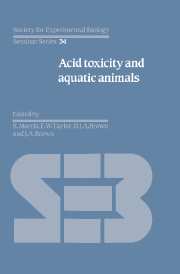Book contents
- Frontmatter
- Contents
- Contributors
- Units, Symbols and Formulae
- Preface
- Introduction: The causes and consequences of surface water acidification
- Invertebrate communities in acid streams
- Fish survival in acid waters
- Field studies on fisheries in acid waters in the UK
- Episodic changes in water quality and their effects on fish
- Acid–base regulation in fishes: 1. Mechanisms
- Acid–base regulation in fishes: 2. Biological responses and limitations
- Intracellular pH regulation and the effects of external acidification
- The physiological problems of fish in acid waters
- Laboratory studies on invertebrate survival and physiology in acid waters
- The physiological problems of crayfish in acid waters
- The effects of hydrogen and aluminium ions on fish gills
- The combined effects of pH and trace metals on fish ionoregulation
- Endocrine responses to acid stress in fish
- Commentary and conclusions
- Index
Introduction: The causes and consequences of surface water acidification
Published online by Cambridge University Press: 05 February 2012
- Frontmatter
- Contents
- Contributors
- Units, Symbols and Formulae
- Preface
- Introduction: The causes and consequences of surface water acidification
- Invertebrate communities in acid streams
- Fish survival in acid waters
- Field studies on fisheries in acid waters in the UK
- Episodic changes in water quality and their effects on fish
- Acid–base regulation in fishes: 1. Mechanisms
- Acid–base regulation in fishes: 2. Biological responses and limitations
- Intracellular pH regulation and the effects of external acidification
- The physiological problems of fish in acid waters
- Laboratory studies on invertebrate survival and physiology in acid waters
- The physiological problems of crayfish in acid waters
- The effects of hydrogen and aluminium ions on fish gills
- The combined effects of pH and trace metals on fish ionoregulation
- Endocrine responses to acid stress in fish
- Commentary and conclusions
- Index
Summary
Introduction
Acid rain is a short-hand term that covers a set of highly complex and controversial environmental problems. It is a subject in which emotive and political judgements tend to obscure the underlying scientific issues which are fairly easily stated but poorly understood. In this article I shall deal solely with the scientific problems involved in the acidification of surface waters, attempt to establish the facts, describe the present state of knowledge and understanding and discuss what research is needed to provide a firm basis for remedial action.
Although the term acid rain is commonly used to describe all acid deposition from the atmosphere that may cause damage to trees, vegetation, fisheries, buildings, etc., in fact rain (and snow) brings down only about one third of the total acids over the UK, two thirds being deposited in the dry state as gases and small particles. But wet or dry, there is little doubt that acid deposition from the atmosphere poses an ecological threat, especially to aquatic life in streams and lakes on hard rocks and thin soils in southern Scandinavia and in some parts of Scotland and North America. A great deal of research is being undertaken in these three areas but this account is based largely on work in Scandinavia and the United Kingdom where more than 30 research groups from a wide variety of disciplines and institutions are working in a closely integrated and coordinated programme under the author's direction.
- Type
- Chapter
- Information
- Acid Toxicity and Aquatic Animals , pp. 1 - 12Publisher: Cambridge University PressPrint publication year: 1989
- 2
- Cited by



